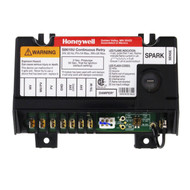Proactive Replacement of the S8610U3009 Ignition Module: Enhancing HVAC Efficiency and Safety
Published by James S. and Bert on Aug 23rd 2023
In the vast and intricate world of HVAC systems, the longevity and efficiency of the entire system often hinge on the health of its components. One of the critical elements in many gas-fired heating systems is the ignition module. The Honeywell S86XXXX series of Ignition Modules stands out as a premier component in this regard. This article delves into the importance of proactively replacing old Ignition Modules, or even an older S8610U3009 Ignition Module, with the current universal replacement model, the S8610U3009, as a preventative maintenance step.
Why the Ignition Module Matters
Manufactured by Honeywell, a trusted brand in the HVAC industry, the S86XXXX (now branded "Resideo", a spin off of Honeywell) are a series of intermittent pilot ignition module. This component is responsible for controlling the ignition process in gas-fired appliances, ensuring they start safely and efficiently every time. Over time, like all electronic components, wear and tear can degrade its performance.
Benefits of Proactive Replacement
- Ensuring Consistent Operation: An aging or malfunctioning ignition module might result in the system failing to start occasionally or exhibit delayed ignition. Proactive replacement ensures that these disruptions do not occur, offering homeowners peace of mind.
- Safety First: A worn ignition module might not control the ignition process efficiently, potentially leading to gas build-up and incomplete combustion – both of which pose safety risks. By replacing it proactively, one can mitigate these risks considerably.
- Energy Efficiency: A fully functional ignition module ensures optimal combustion, which translates to more efficient fuel use and reduced wastage. This not only helps save on energy bills but also benefits the environment.
- Longevity of the System: Ensuring that every component of the HVAC system is in top shape reduces undue stress on other parts. By proactively replacing the S8610U3009 module, homeowners might be extending the life of their entire heating system.
- Cost Savings in the Long Run: Waiting for a component to fail entirely often results in emergency repair calls which can be more expensive than scheduled maintenance. Furthermore, a malfunctioning ignition module might cause damage to other parts of the system, leading to more significant repair costs.
When to Consider Replacement?
While the S86XXXX Ignition Modules are designed for durability, it's prudent to watch out for signs that might indicate it's due for a replacement:
- Age of the Component: If the module has been in service for many years, even if it hasn’t shown signs of malfunction, it might be time for a proactive replacement.
- Inconsistent Ignition: If the system struggles to start or has intermittent ignition failures, the module could be the culprit.
- Noticeable Increase in Gas Consumption: An inefficient ignition process might result in higher gas consumption. If all other factors remain constant, an aging ignition module might be the reason for the spike in gas bills.
Conclusion
Preventative maintenance is a cornerstone principle for ensuring the longevity, efficiency, and safety of HVAC systems. The proactive replacement of components by the universal replacement model: S8610U3009 Ignition Module by Honeywell/Resideo underscores this principle. Have your installer check the compatibility table to ensure the new universal module will replace your older module. The full model number of your older module is often on a tag on the left side of the controller. For homeowners and maintenance professionals alike, understanding the pivotal role of such components and the benefits of timely replacements can make all the difference in ensuring a warm, safe, and comfortable living environment. As is always the case with gas related combustion products, make sure you hire a qualified, experienced technician to do the job. Homeowners should not attempt this work themselves due to the risk of fire and explosion.

